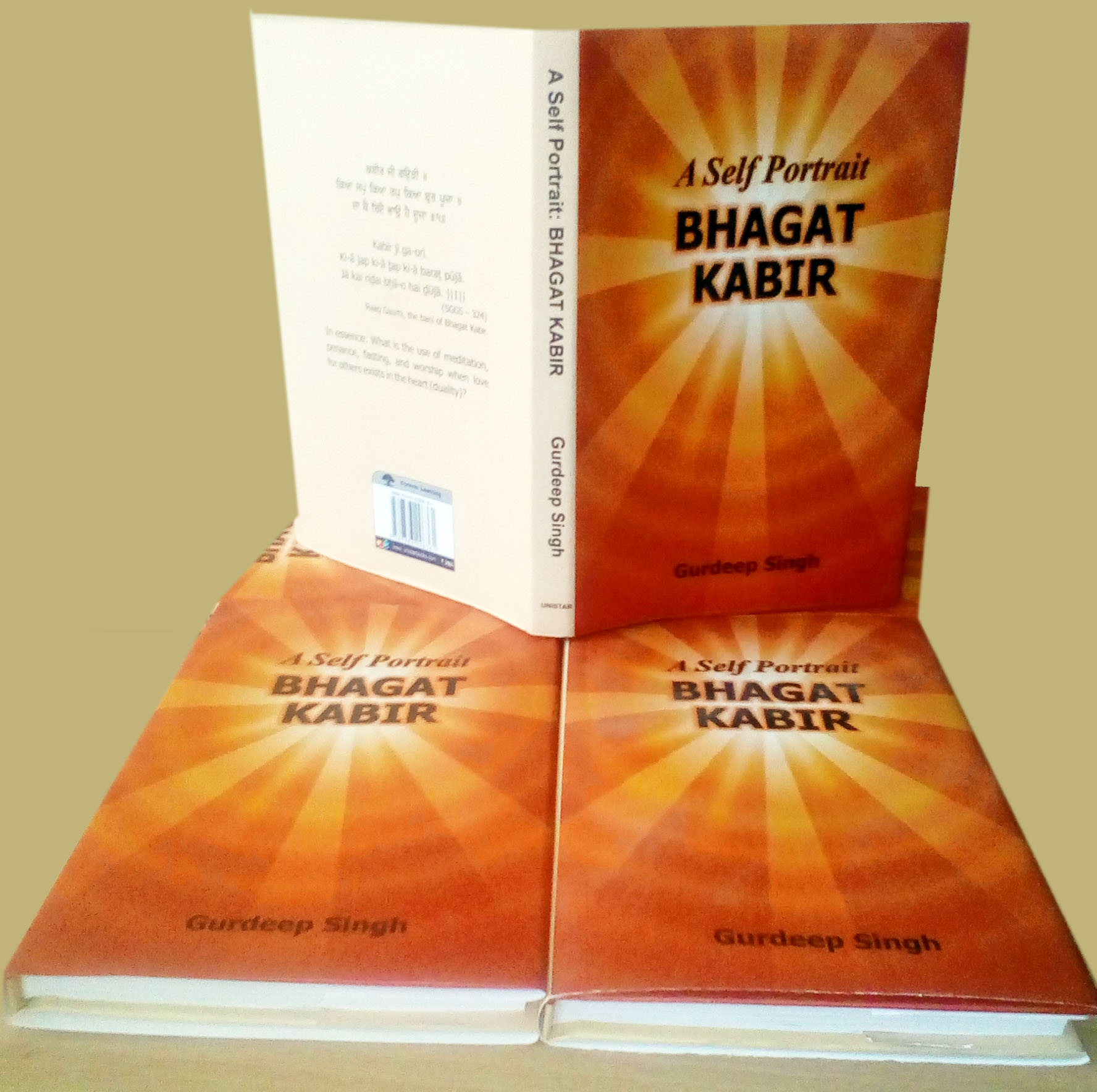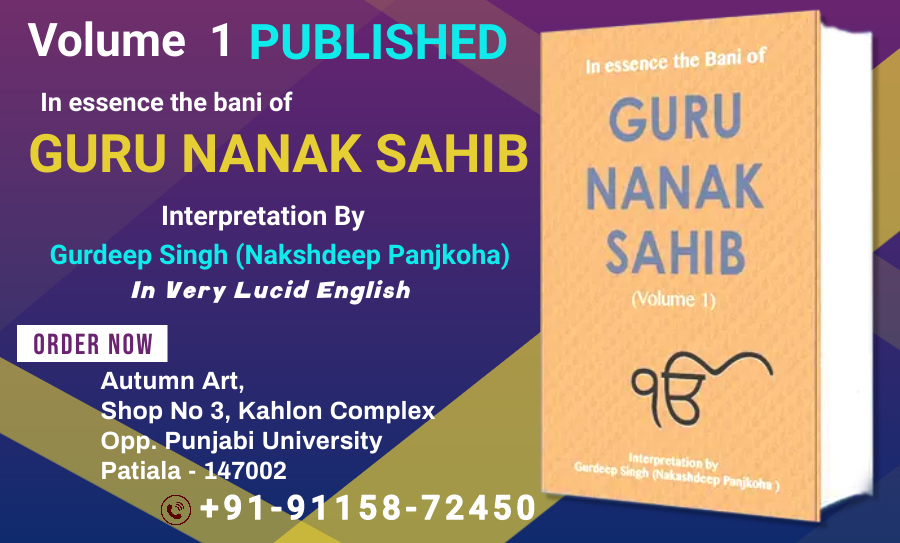On a scientific measure, the existence of the Creator, expressed in various scriptures, cannot be proved; nonetheless, there is something within the human beings that inspires them to experience the power that is a cause of the world and beyond. In Sikhi, though that entity is addressed mostly as masculine, it is also made clear that it is beyond gender. Using masculine pronouns to identify the Creator is just a way of expressing the inexpressible power. In philosophical terms, many words are used to express the Creator, but those words remain deficient to express Him. According to First Nanak, that entity, you may call it “Self”, or “Inner Self, or “Super conscious”, or “Mind”, or “All Pervading Light”, cannot just be explained in words but realized. According to him, Ekankar, addressed by the worldly people with numerous names, is the only one that exists in eternal manner; His creation is in process of change continuously without any let up; however, He pervades the Creation and also watches it as an independent entity. We will look at his bani that supports this point.
As long as we deem the Creator as being away up in the sky, it will be very difficult to realize Him according to the Gurbani, because separating Him from His creation is creating duality that creates a big abyss between Him and His seeker. Repeatedly it is said in the Gurbani that the Creator is always present in His creation. Its message is to become one with the Creator while living in the world without ever renouncing it since it has been His own part. As He is unborn, showing Him reacting like a human being is a big fallacy.
First Nanak has given hints about His identification in the Mool mantra, a prelude to his bani called “Japji” and he further elaborates on this issue in his various shabdas. If we understand all the words used in “the Mool Mantra”, it becomes easy for us to identify His very much presence in us as well as His own independent existence. Let us look at that in detail; it is on 1, SGGS:
ੴ ਸਤਿ ਨਾਮੁ ਕਰਤਾ ਪੁਰਖੁ
ਨਿਰਭਉ ਨਿਰਵੈਰੁ ਅਕਾਲ ਮੂਰਤਿ ਅਜੂਨੀ ਸੈਭੰ ਗੁਰ ਪ੍ਰਸਾਦਿ ॥
Ik-oaʼnkār saṯ nām karṯā purakẖ
nirbẖa-o nirvair akāl mūraṯ ajūnī saibẖaʼn gur parsāḏ.
In essence: There is only one all pervading Creator, whose name is a reality. He is the Creator, who is beyond fear and animosity. His form is beyond death and birth. He is from Himself (self illumined); He is known through the Guru’s blessings.
The pronoun “He”, used above, doesn’t prove Him actually to be of any gender as said earlier; in the realm of liberation, in the Gurbani, the Creator is addressed as an eternal Spouse where as `all other human lives as His brides:
ਠਾਕਹੁ ਮਨੂਆ ਰਾਖਹੁ ਠਾਇ ॥ ਠਹਕਿ ਮੁਈ ਅਵਗੁਣਿ ਪਛੁਤਾਇ ॥
ਠਾਕੁਰੁ ਏਕੁ ਸਬਾਈ ਨਾਰਿ ॥ ਬਹੁਤੇ ਵੇਸ ਕਰੇ ਕੂੜਿਆਰਿ
Thaakahu manoo-aa raakho thaa-ay. Thahak mu-ee avgun pachhutaa-ay.
Thaakur ayk sabaa-ee naar. Bahutay vays karay koorhi-aar.. ||29||
(933, SGGS)
In essence: Still your mind by restraining it to its place. The world goes through tremendous miseries in strife because of its bad deeds; it repents consequently. There is only one Spouse, Prabh, and all others are His brides. False one assumes many religious garbs.
It will be useful to understand the concept of the Creator explained by First Nanak if we understand “ੴ”; it will also become easy to understand toward whom the Guru leads his followers. First, ੧ is a symbol of number one; First Nanak himself on 57, SGGS, does its usage and description:
ਨਾਨਕ ਏਕੋ ਰਵਿ ਰਹਿਆ ਦੂਜਾ ਅਵਰੁ ਨ ਕੋਇ ॥੮॥੬॥
Nānak eko rav rahi-ā ḏūjā avar na ko-e. ||8||6||
{SGGS–57}
Oh Nanak! There is none but only one (Akalpurakh), who is pervading all over.
And, on 350, SGGS, he says:
ਸਾਹਿਬੁ ਮੇਰਾ ਏਕੋ ਹੈ ॥
ਏਕੋ ਹੈ ਭਾਈ ਏਕੋ ਹੈ ॥੧॥ ਰਹਾਉ ॥
Sāhib merā eko hai.
Ėko hai bẖā-ī eko hai. ||1|| rahā-o.
{SGGS–350}
My Master is but one. Oh brother! My Master is one only. Pause.
In the following verses, the virtues of “the only one Creator” are expressed as the Guru defines Him as a unique entity on 9, SGGS:
ਨਾ ਓਹੁ ਮਰੈ ਨ ਹੋਵੈ ਸੋਗੁ ॥ ਦੇਦਾ ਰਹੈ ਨ ਚੂਕੈ ਭੋਗੁ ॥
ਗੁਣੁ ਏਹੋ ਹੋਰੁ ਨਾਹੀ ਕੋਇ ॥ ਨਾ ਕੋ ਹੋਆ ਨਾ ਕੋ ਹੋਇ ॥੩॥
Nā oh marai na hovai sog. Ḏeḏā rahai na cẖūkai bẖog.
Guṇ eho hor nāhī ko-e. Nā ko ho-ā nā ko ho-e. ||3||
{SGGS–9}
In essence: Ekankar doesn’t die; therefore, there is no mourning for Him (all people die and they are mourned); He keeps giving and the prevision of “His giving away” doesn’t run out. This is a quality of Ekankar that there is none like Him; neither like Him existed before, nor would be ever.
This way, the Guru stresses on the Creator’s being only one; therefore, ੴis one word all together.
Second, the second part of “ੴ” is “ਓ” = ਓਅੰ; Dr. Sahib Singh writes: It is a word of Sanskrit used in three contexts:
a). To be written in the beginning of a sacred scripture.
b). To say “yes” in response to an order given by someone.
c). It is used for the Creator.
Bhai Gurdas in Vaar 3, stanza 15, describes what “ਓ” stands for, and that is “Onkar”; he also says that by using “੧ Eka/one” (“not ikk”) with ਓ, the Guru makes it “Ekankar.” Basically, it is Onkar, who creates (1003, SGGS). It is also the Guru’s rejection of the three entities, established in the Hindu scriptures, having different jobs like one creates, other one kills and the third one provides sustenance to the created ones; it is on 7, SGGS.
ਏਕਾ ਮਾਈ ਜੁਗਤਿ ਵਿਆਈ ਤਿਨਿ ਚੇਲੇ ਪਰਵਾਣੁ ॥
ਇਕੁ ਸੰਸਾਰੀ ਇਕੁ ਭੰਡਾਰੀ ਇਕੁ ਲਾਏ ਦੀਬਾਣੁ ॥
Ėkā mā-ī jugaṯ vi-ā-ī ṯin cẖele parvāṇ.
Ik sansārī ik bẖandārī ik lā-e ḏībāṇ.
{SGGS–7}
In essence: From Maya have come the three accepted (by some) disciples (obedient sons of Maya) into existence; (It is believed) one of them became house-holder (as a family man who makes babies); the second one of them takes care of the creation with the stores he has and the third one of them sets up the court (to decide who should die).
Interestingly, the Guru rejects all of them by acknowledging only Ekankar as the sole doer of everything by saying that the people just don’t see Him though He does exist (7, SGGS).
ਜਿਵ ਤਿਸੁ ਭਾਵੈ ਤਿਵੈ ਚਲਾਵੈ ਜਿਵ ਹੋਵੈ ਫੁਰਮਾਣੁ ॥
Jiv ṯis bẖāvai ṯivai cẖalāvai jiv hovai furmāṇ.
(Actually) As it pleases Ekankar, He runs His affairs according to His ordinance.
This is what the Guru wants to pass on to his followers; he is simply saying that there is only Ekankar, who runs the worldly show not those three ones accepted by some people. This concept of one Creator is repeated in Sri Guru Granth Sahib. Some people try to distort the Guru message just by sticking to above first two verses of this stanza by ignoring the last verse that negates their existence.
ਓਹੁ ਵੇਖੈ ਓਨਾ ਨਦਰਿ ਨ ਆਵੈ ਬਹੁਤਾ ਏਹੁ ਵਿਡਾਣੁ ॥
Oh vekẖai onā naḏar na āvai bahuṯā ehu vidāṇ.
It is a great wonder that Ekankar watches them, but they cannot see Him.
The Guru states the Creator, who alone runs all the worlds and watches them; however, He remains unseen amazingly. The Guru keeps stressing that we should bow only to our Creator, Ekankar, not Maya and her disciples named as Brahma, Vishnu and Shiva.
By using ੧ and ਓ together, First Nanak names “Onkar” as “Ekankar”. In Sri Guru Granth Sahib I haven’t found “Ikk Onkar” but “Ekankar”. Many Sikhs pronounce “੧” as “ikk onkar” also; Ekankar is referred in SGGS for the all-pervading Creator. Please also keep in mind that when “one” (ieku Ikk) is actually used with Ekankar, then the Gurmukhi-lipi-ounkud (vowel) of the last letter is taken off; examples:
ਦ੍ਰਿਸਟਿ ਆਵੈ ਸਭੁ ਏਕੰਕਾਰੁ ॥੨॥
Ḏarisat āvai sabẖ ekankār. ||2||
(On 189, SGGS,)
Means: Everywhere Ekankar is seen.
Above, “ਇਕੁ / IKK” is not used before Ekankar and ounkud ( – ) is used with its last letter.
ਸਦਾ ਸਦਾ ਇਕੁ ਏਕੰਕਾਰ ॥
Saḏā saḏā ik ekankār.
{SGGS–276}
Means: Forever is only (one) Ekankar.
Now above see ਇਕ /IKK is used before Ekankar, but Ounkud (-) is taken off. Above ਇਕ is used as an adjective not noun. On 736, SGGS, oneness of the Creator, including His creation, is expressed by using Ekankar without Ounkud. Here is Fifth Nanak:
ਭ੍ਰਮਨ ਛੂਟੇ ਤੇ ਏਕੰਕਾਰ ॥੩॥
Bharam chhootay tay aikankaar. ||3||
{SGGS–736}
Means: When one’s doubt is eliminated, one sees only Ekankar.
Obviously, First Nanak expresses oneness of the Creator by replacing the prevailed and frequently used word “OM” with “ੴ”
The next word “ਸਤਿ”is about the doubtless existence of the Creator; it also states the eternity of His existence.
ਸਤਿ: Means reality with existence. It is also expressed by using the word “ਸਚੁ ” which means “eternal”, but the eternity of Ekankar is also expressed through the words “ਅਕਾਲ ਮੂਰਤਿ/Akāl Mūraṯ” and the slok that follows “Jap”. .
ਨਾਮੁ /Naam/name is not only used for the name of the Creator but also for the Creator Himself; in other words, ਨਾਮ is used as Ekankar, or Akalpurakh, Har, Prabh and His other names. Looking at the following verses, no doubt remains that ਨਾਮ stands for the Creator as well ; examples: 284, SGGS:
ਨਾਮ ਕੇ ਧਾਰੇ ਸਗਲੇ ਜੰਤ ॥
ਨਾਮ ਕੇ ਧਾਰੇ ਖੰਡ ਬ੍ਰਹਮੰਡ ॥
Nām ke ḏẖāre sagle janṯ.
Nām ke ḏẖāre kẖand barahmand.
{SGGS–284}
In essence: Akalpurakh (ਨਾਮ) has established the lives. Akalpurakh has established the earth and the solar systems.
246, SGGS, ਨਾਮ / Naam is used for Akalpurakh and His name as well:
ਨਾਮੇ ਉਪਜੈ ਨਾਮੇ ਬਿਨਸੈ ਨਾਮੇ ਸਚਿ ਸਮਾਏ ॥
Nāme upjai nāme binsai nāme sacẖ samā-e.
{SGGS–246}
In essence: From Naam “(Ekankar)” we emanate; we will perish into Naam, “Ekankar”; through ਨਾਮੇ / ਨਾਮ /His name, we get absorbed in Ekankar.
Besides, “ਨਾਮ / Naam”, ਨਾਉ naaon” or “ਨਾਵੈ/naavain” is also used in the same manner; examples on 19, SGGS:
ਤਨ ਸੂਚਾ ਸੋ ਆਖੀਐ ਜਿਸੁ ਮਹਿ ਸਾਚਾ ਨਾਉ ॥
Ŧan sūcẖā so ākẖī-ai jis mėh sācẖā nā-o.
{SGGS–19}
In essence: Pure is that person (body) in whom dwells the name of the eternal Creator. And on 27, SGGS:
ਮਨਮੁਖ ਗੁਣ ਤੈ ਬਾਹਰੇ ਬਿਨੁ ਨਾਵੈ ਮਰਦੇ ਝੂਰਿ ॥੨॥
Manmukẖ guṇ ṯai bāhre bin nāvai marḏe jẖūr. ||2||
{SGGS–27}
In essence: The mind-slaves die in frustration without His name and virtues.
Very clearly, the Guru advises his followers to utter ਸਤਿਨਾਮੁ repeatedly, for an example see on 670, SGGS:
ਜਪਿ ਮਨ ਸਤਿਨਾਮੁ ਸਦਾ ਸਤਿਨਾਮੁ ॥
Jap man saṯ nām saḏā saṯ nām.
{SGGS–670}
In essence: Oh mind! Utter Satnaam always repeatedly.
On 1083, SGGS, Fifth Guru deems ਸਤਿ as the primal name compared to His names given as per His power of actions:
ਕਿਰਤਮ ਨਾਮ ਕਥੇ ਤੇਰੇ ਜਿਹਬਾ ॥
ਸਤਿ ਨਾਮੁ ਤੇਰਾ ਪਰਾ ਪੂਰਬਲਾ ॥
Kirṯam nām kathe ṯere jihbā.
Saṯ nām ṯerā parā pūrbalā.
{SGGS–1083}
In essence: My tongue utters your given names (as per your acts/virtues), but “Sat” is your primal name.
Obviously, “Sat” should also be taken as Ekankar’s name. When the Guru talks about obtaining“ਨਾਮ/ His name”, it appears that he talks about recognizing/realizing the Creator’s presence/light within and out.
The next word indicates about the Creator’s active force.
ਕਰਤਾ ਪੁਰਖੁ: Usually “Purakh” commonly taken as a man (masculine gender); however, its usage differs in various contexts; it is used for a special Guru and also for a common man (without gender: as we use a man as a human being). Pur +akh becomes Purakh(Sanskrit). Pur means something, a body or a realm or a space; kh means “to be in”. As “a soul is in a man” (here “man” is taken as beyond gender); therefore, Purakh is taken as a man (beyond gender), but it has become common with masculine gender. In the Gurbani, it is used for the Creator, who permeates His creation; therefore, it should not be solely interpreted as masculine entity as explained earlier. The word, “ਕਰਤਾ” expresses the power of creating. Together “ਕਰਤਾ ਪੁਰਖੁ” means the Creator, who permeates all. The Guru rejects Abrahamical concept of “the Creator’s separation from His creation” by using ਪੁਰਖੁ with ਕਰਤਾ. Obviously Purakh is used to express the Creator’s presence in the Creation. Fourth Nanak describes “ਕਰਤਾ ਪੁਰਖੁ” beautifully on 11, SGGS:
ਤੂੰ ਆਦਿ ਪੁਰਖੁ ਅਪਰੰਪਰੁ ਕਰਤਾ ਜੀ ਤੁਧੁ ਜੇਵਡੁ ਅਵਰੁ ਨ ਕੋਈ ॥
ਤੂੰ ਜੁਗੁ ਜੁਗੁ ਏਕੋ ਸਦਾ ਸਦਾ ਤੂੰ ਏਕੋ ਜੀ ਤੂੰ ਨਿਹਚਲੁ ਕਰਤਾ ਸੋਈ ॥
Ŧūʼn āḏ purakẖ aprampar karṯā jī ṯuḏẖ jevad avar na ko-ī.
Ŧūʼn jug jug eko saḏā saḏā ṯūʼn eko jī ṯūʼn nihcẖal karṯā so-ī.
{SGGS–11}
In essence: Oh Akalpurakh! You are the primal being; you are the all pervading and infinite Creator. None is other one, who is equal to you. Only you have been here throughout all ages; you are the same eternal Creator: changeless and beyond any special form.
ਨਿਰਭਉ: ਨਿਰ means without; ਭਉ means fear. It is a virtue of the all-pervading Creator to be beyond fear. Why should the Creator fear from anyone or anything when He is the Creator of all? Besides, a power, present in all and everywhere, should be above fearing emotion. The Guru also addresses Ekankar as ਨਿਰਭਉ on 12, SGGS:
ਤੁਮ ਗਾਵਹੁ ਮੇਰੇ ਨਿਰਭਉ ਕਾ ਸੋਹਿਲਾ ॥
ਹਉ ਵਾਰੀ ਜਿਤੁ ਸੋਹਿਲੈ ਸਦਾ ਸੁਖੁ ਹੋਇ ॥੧॥ ਰਹਾਉ ॥
Ŧum gāvhu mere nirbẖa-o kā sohilā.
Ha-o vārī jiṯ sohilai saḏā sukẖ ho-e. ||1|| rahā-o.
{SGGS–12}
In essence: (Oh friends) you sing a song praising my Fearless (Ekankar); I sacrifice to that song of His praise, which brings ever peace. Pause.
ਨਿਰਵੈਰੁ: ਨਿਰ means without, ਵੈਰੁ means animosity. Like ਨਿਰਭਉ ਨਿਰਵੈਰੁ is also emotional feeling, but the Creator is beyond human feelings; in other words, He doesn’t feel or act individually like a human being. Why the Creator should harbor any feeling like animosity or fear? The Guru continues advising his followers to acquire these virtues of the Creator expressed in Sri Guru Granth Sahib.
ਅਕਾਲ ਮੂਰਤਿ: “ਅਕਾਲ” means beyond death, because “ਕਾਲ” means death or end. ਅ means not; with it, the Guru uses the word ਮੂਰਤਿ to express the existence of the Creator beyond a limited form. When we go through Sri Guru Granth Sahib, it becomes crystal clear that the Guru also calls the Creator as ਸਰਗੁਣੁ with attributes (His being present in His Creation) and ਨਿਰਗੁਣ without attributes (beyond limited presence); therefore, it is stressed that the existence of the Creator is a reality, and His existence is beyond end or destruction.
ਅਜੂਨੀ: Means beyond birth; whatever comes into birth remains subject to death; therefore, being “ਅਕਾਲ” the Creator doesn’t come into an existence individually. Wherever in the Gurbani, it is stated that there is no difference between the Creator and His true devotees, we should not take its literal meaning; for example, look at the following verses on 397, SGGS.
ਆਸਾ ਮਹਲਾ ੫ ॥
ਜਿਨ੍ਹ੍ਹਾ ਨ ਵਿਸਰੈ ਨਾਮੁ ਸੇ ਕਿਨੇਹਿਆ ॥
ਭੇਦੁ ਨ ਜਾਣਹੁ ਮੂਲਿ ਸਾਂਈ ਜੇਹਿਆ ॥੧॥
Āsā mėhlā 5.
Jinĥā na visrai nām se kinehi-ā.
Bẖeḏ na jāṇhu mūl sāʼn-ī jehi-ā. ||1||
{SGGS–397}
Raag Asa, the bani of fifth Nanak.
In essence: Like what are those persons, who never forget Ekankar’s name? (Answer) Do not see any difference between them and the Master, Ekankar; they are just like Him.
Why? Answer lies in their becoming one after realizing His light present within and seeing Him permeating everyone and everywhere.
His devotees are Ekankar’s ਸਰਗੁਣੁ form perfectly with attributes, but He is also ਨਿਰਗੁਣ without attributes. Through such verses, the Guru expresses the sublime status of the enlightened ones, who become one with the Creator by acquiring His virtues like to be immaculate and beyond fear and animosity. While reading such verses, the true Sikhs, should not disobey the Guru, who says that the Creator doesn’t take birth or die.
ਸੈਭੰ: Means the Creator is from Himself (self illumined); in other words, He Himself is the source of His existence. This word also gives a subtle meaning of the verse below in “Jap” stanza, 4:
ਜੇਤਾ ਕੀਤਾ ਤੇਤਾ ਨਾਉ ॥
ਵਿਣੁ ਨਾਵੈ ਨਾਹੀ ਕੋ ਥਾਉ ॥
Jeṯā kīṯā ṯeṯā nā-o.
viṇ nāvai nāhī ko thā-o.
{SGGS–4}
There is not a place without Ekankar (name); all what Ekankar has created is His name (He is everything.).
ਗੁਰ ਪ੍ਰਸਾਦਿ: Bhai Veer Singh ji describes ਗੁਰ in Santhya Sri Guru Granth Sahib, Page 31; he says: ਗੁਰ is a compound as Rara (r) is free from any vowel; therefore, its meaning is “the Guru’s. And, ਪ੍ਰਸਾਦਿ means happiness or blessings. Here it is taken as blessings; on 923, SGGS, its context is made clear:
ਪਰਸਾਦਿ ਨਾਨਕ ਗੁਰੂ ਅੰਗਦ ਪਰਮ ਪਦਵੀ ਪਾਵਹੇ ॥
Parsāḏ Nānak gurū angaḏ param paḏvī pāvhe.
{SGGS–923}
In essence: With the blessings of Guru Nanak, Guru Angad has obtained the supreme status.
And on 905, SGGS:
ਜਿਸੁ ਗੁਰ ਪਰਸਾਦੀ ਨਾਮੁ ਅਧਾਰੁ ॥
ਕੋਟਿ ਮਧੇ ਕੋ ਜਨੁ ਆਪਾਰੁ ॥੭॥
Jis gur parsādī nām aḏẖār.
Kot maḏẖe ko jan āpār. ||7||
{SGGS–905}
In essence: That one, for whom Prabh’s name becomes support of life with the Guru’s blessings, is an unequalled in millions.
So ਗੁਰ ਪ੍ਰਸਾਦਿ means: the Creator already described is known through the blessings of the Guru.
After naming the Creator as ੴEkankar and expressing His oneness, the Guru qualifies Him with His unique virtues in a nutshell; throughout the bani “Jap”, the description of Ekankar continues through the words like ordinance, His power to permeate His creation, His power of giving sustenance to all the lives, the power in His praise and the Creator’s infinite power over the entire nature and beyond. By repeatedly referring to Mool Mantra in short or in full version, the Guru doesn’t let his follower misunderstand the Creator with any misleading statement about Him.
(CONTINUES)
Wishes
G Singh





